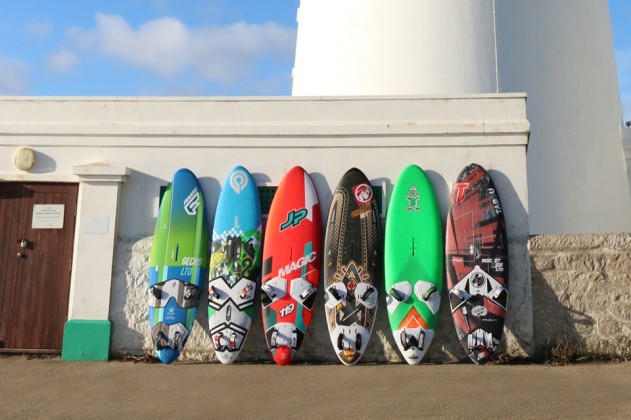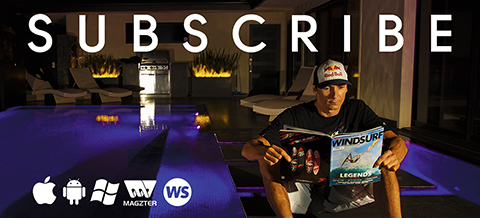THE SHINING LIGHTS OF FREERIDE
115L FREERIDE BOARD TEST 2016
Test Editor Tris Best // Second Testers Maurin Rottenwalbter and Joe North
Photos Tris Best // Test Location OTC, Portland, Dorset
Over the years the discipline of freeride has morphed into a mammoth of a class, so much so that it has spurned a number of sub-categories, from freewave to freemove and freerace. There’s even a major brand using the term freecarve… So what do all these new splinter classes equate to? Surely division only serves to confuse the situation?
This test was originally published in the March 2016 issue.
Without going into masses of detail (as now is neither the time nor place … and I’d be told off by the editor for writing a mini-thesis!) I’ll try to break the freeride monster down into a couple of simple rules so that you can make sense of any marketing hyperbole engulfing any freeride reclassification. The first rule is this: any windsurfing class with ‘free’ in front of it simply means that the equipment is targeted towards the consumer market. That is to say towards recreational sailors like you and I. And to that end, the kit should have two very clear objectives – (1) Be easy and user-friendly to sail, and (2) above all else be fun and rewarding to use. The fun and rewarding part can take many different guises – it could be fast; it could be easy to carve and get round corners; have a lively and exciting character … or major purely on control to bestow confidence in the planing first-timer. The key to success is that it performs beyond the expectations of the rider and therefore flatters their style and ability. That way the rider comes off the water at the end of the session craving more … and the equipment’s mission is achieved! Of course, there is one discipline that is the exception to this first rule … and that is freestyle. The simple reason, is that from its inception, freestyle soon became a competition discipline and whenever that happens the equipment developed has the sole purpose to help the talented few win an event, rather than be easy and user-friendly for the masses.
The second rule relates to the other word used with ‘free’ in the reclassification. Its purpose is to give some indication as to the market segment the brand in question is trying to push the product towards. So for example, a freewave board is a user-friendly board intended for use in and around a wave-break. A freerace board is intended for informal racing or blasting at a recreational level. A freemove board is an easy, user-friendly platform that will assist the pilot in developing their abilities in planing conditions, be it in a straight-line or around corners.
Taking an objective view as to how the class of freeride has evolved, you can begin to understand why the sub-categories have been introduced. The consumer market is the foundation of the industry, the very bedrock that enables it to survive. So as more and more boards and sails are pushed into the freeride sector, reclassification had to occur to help distinguish between design paths and directions. On the plus side, the big melting pot that is now the freeride discipline has never been healthier and has benefited from all the attention that it deservedly commands from the brands
FINDINGS
The ‘wide and thin’ concept, which various brands lay claim to pioneering initially (yet few are ignoring today), has undoubtedly breathed new life into the ‘freeride’ discipline. The main advantage to the concept is that it makes the best use of the board’s volume, and thereby extends the board’s usable wind range. Comparing a modern wide-and-thin-style design to a more conventional freeride board, you can get away with a board of less volume to carry the large light wind sail, because the extra width provides more stability (also aided, more often than not, by a flat deck). The reduced volumes (and thinner rails) then impart their virtues on the board’s performance, imparting better response and feel through manoeuvres before displaying the trump card of greater control when the wind increases and sail size reduces.
An interesting development from this concept is the way in which brands push their new breed of boards. Some brands are simply noting that you can now drop down a volume size to match your existing sail quiver … yet I would be hesitant in painting the decision of which board you choose with such a broad brush. The best analogy I read was from Starboard that state for their Atom iQ –an advanced sailor should pick the Atom iQ with the same width as their existing board; whereas a progressing sailor should opt for the Atom iQ of the same volume as their existing board.
So, if the ‘wide and thin’ board is so good, why would you ever choose anything else? Well, the truth is that some riders (particularly the infrequent sailor … or those that are re-engaging with the sport after a break) simply don’t like the feel of the wide-thin designs, and take particular exception to their early planing credentials. We’ve seen it quite a few times when hiring kit to people in the centre. The reason is that there needs to be a change in technique to get a board going. On a conventional board, you feel the power come on, then step back and plough the power of the sail through the back foot and into the fin, helping to drive the board clear of the water. In the modern wide and thin board, the most effective technique to plane early requires you to use the board’s hull and not just the fin, stuffing the board downwind like a wave board and pushing through the front foot instead of just the back-foot. Get this right and the new-style board will explode from the blocks. But it does take a bit of getting used to if you’ve been windsurfing for a long time and used to older designs.
SUMMARY
A quick summary of the designs on display. The Goya is the lone ranger in the pack and shows that the more conventional board outline still undoubtedly has its place in the freeride sector. The Gecko and Firemove are established designs and have deservedly won fans in their time, the Fanatic for its supremely dependable nature and the RRD for its control and smooth manoeuvrability. The JP and Starboard are both new designs for 2016 and show how the wide thin concept is evolving, the Magic Ride with its lively all-round ability and stunning gybing, and the Atom iQ for is captivating blasting energy. That leaves the widest of the pack – the unchanged Tabou, which still amazes us with its almost unnatural blend of user-friendliness and outright performance.
TEST LOCATION
This test was conducted at the Official Test Centre (OTC), on Portland, Dorset. The centre is based within the grounds of the National Sailing Academy that hosted the Olympic sailing classes in 2012. With the best wind stats on the south coast, mirror flat water in prevailing winds and a safe launch area with excellent facilities, it provides the ideal test venue. Much of the kit is still on site, so why not go and try some of it for yourself?
uk.otc-windsurf.com
THE LINE UP


